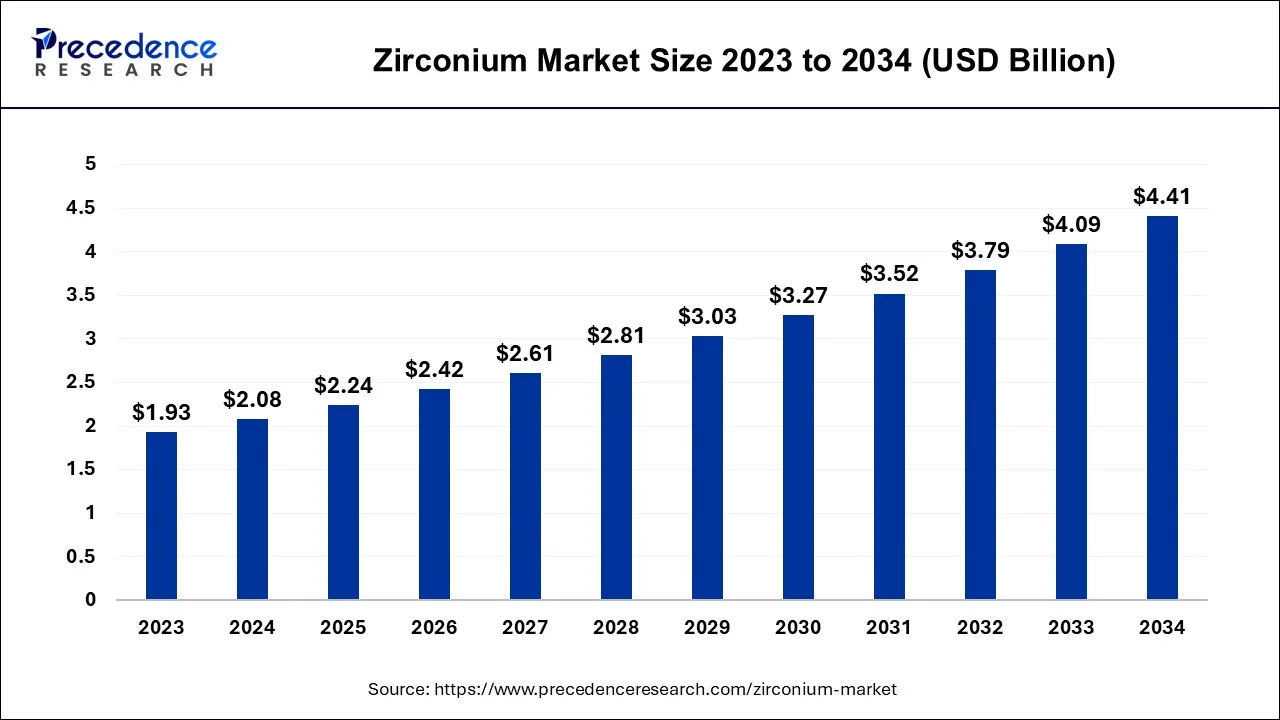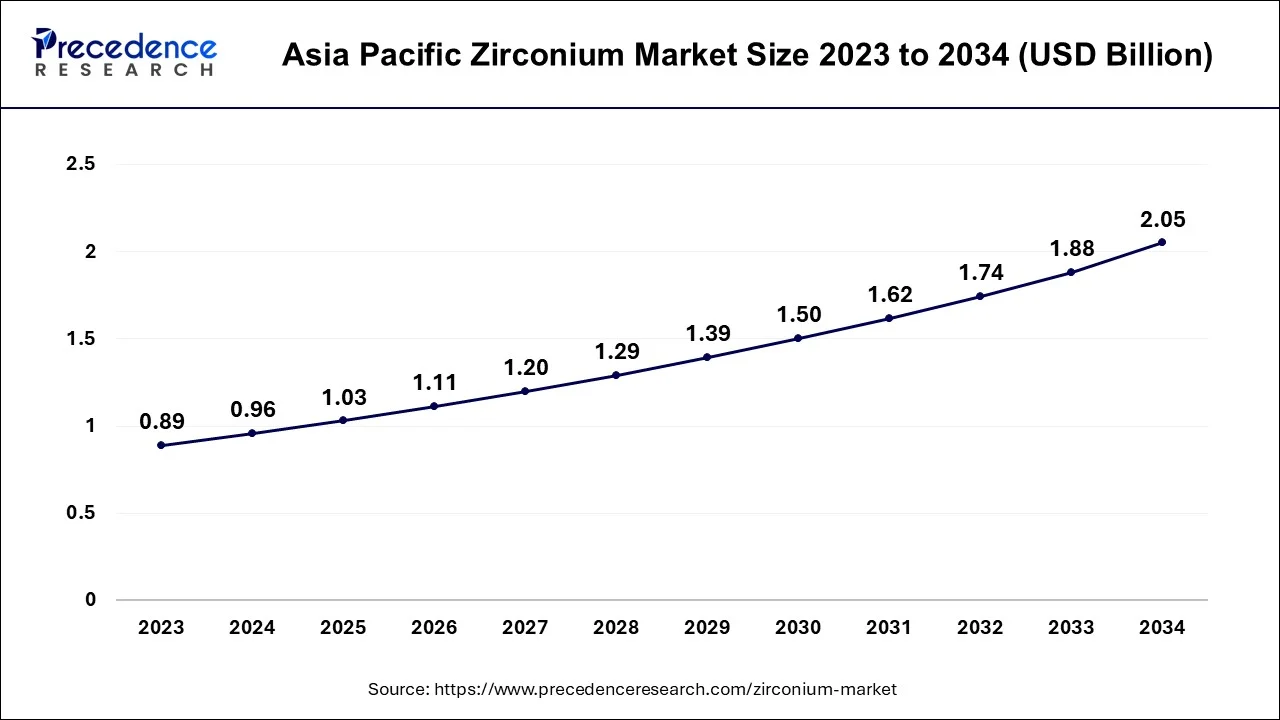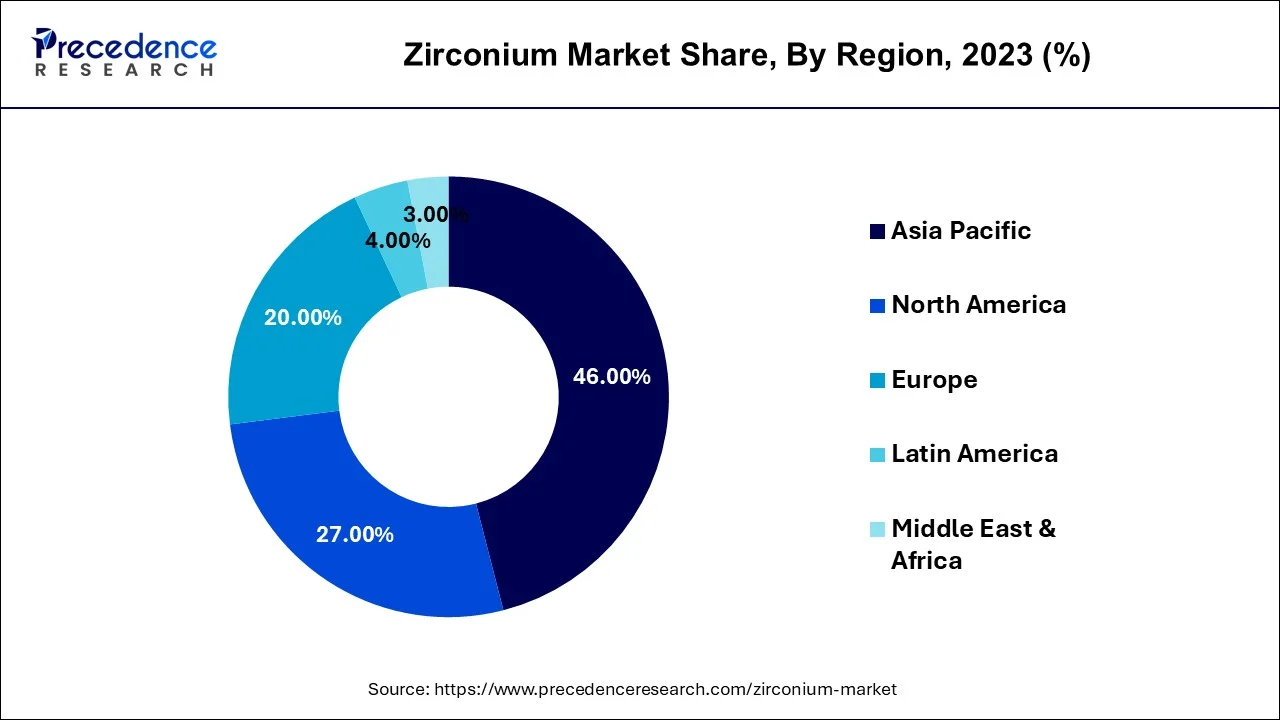The global zirconium market size is estimated at at USD 2.08 billion in 2024, grew to USD 2.24 billion in 2025 and is predicted to surpass around USD 4.41 billion by 2034, expanding at a CAGR of 7.80% between 2024 and 2034.
The global zirconium market size accounted for USD 2.08 billion in 2024 and is anticipated at to reach around USD 4.41 billion by 2034, expanding at a notable CAGR of 7.80% between 2024 and 2034.

The Asia Pacific zirconium market size is estimated at USD 0.83 billion in 2022 and is expected to reach USD 1.73 billion by 2032, growing at a CAGR of 7.70% from 2023 to 2032.

Asia Pacific has held the largest revenue share of 46% in 2023. Asia Pacific exerts significant dominance in the zirconium market, driven by an array of distinctive factors. The region's robust industrial landscape and rapid urbanization dynamics act as pivotal drivers, propelling the demand for zirconium-based materials across diverse sectors, including construction, electronics, and the automotive domain.
Notably, Asia Pacific assumes a leading role in the burgeoning nuclear energy sector, amplifying zirconium's deployment within nuclear applications. The region benefits from bountiful zirconium reserves, notably in countries such as Australia and China, and their proactive involvement in zirconium mining and refining cements Asia Pacific's authoritative position in the global zirconium market.

North America is estimated to observe the fastest expansion. North America holds significant growth in the zirconium market for several reasons. The region boasts a robust aerospace and defense sector, which is a major consumer of zirconium due to its unique properties. Additionally, North America's advanced healthcare industry relies on zirconium for medical implants, further increasing demand.
The continent's well-established manufacturing infrastructure and technological advancements in zirconium production contribute to its dominance. Furthermore, the focus on sustainability and eco-friendly practices aligns with zirconium's recyclability, bolstering its use in various applications. These factors collectively position North America as a key player in the global zirconium market.
The zirconium market is a distinctive and vital segment in the global materials industry. Zirconium, recognized for its resistance to corrosion, holds a pivotal position in nuclear energy, chemical processes, and aerospace applications due to its exceptional qualities. The market's dynamics are closely tied to the performance of these key sectors, rendering it susceptible to market shifts. Primary zirconium production remains limited, with the majority sourced as a byproduct of titanium refining. Prices are influenced by supply-demand dynamics, geopolitical factors, and technological advancements. Although relatively compact compared to other metals, the zirconium market plays a fundamental role in numerous advanced and industrial applications.
| Report Coverage | Details |
| Growth Rate from 2024 to 2034 | CAGR of 7.80% |
| Market Size in 2024 | USD 2.08 Billion |
| Market Size by 2034 | USD 4.41 Billion |
| Largest Market | Asia Pacific |
| Base Year | 2023 |
| Forecast Period | 2024 to 2034 |
| Segments Covered | Occurrence Type, Application, and Region |
| Regions Covered | North America, Europe, Asia-Pacific, Latin America, and Middle East & Africa |
Nuclear energy
Nuclear energy serves as a catalyst of paramount importance, propelling the zirconium market into robust growth. This is attributed to the extraordinary attributes of zirconium, notably its unparalleled resistance to corrosion and its capacity to withstand intense temperatures, rendering it an indispensable cornerstone within nuclear reactors. In a world that increasingly craves sustainable and dependable energy sources, the resurgence of the nuclear industry stands as a pivotal force directly shaping the expansion of the zirconium market.
In the nuclear realm, zirconium finds its vital role primarily in the composition of fuel rods and reactor components. It acts as a protective shield, segregating nuclear fuel from the cooling system, thereby averting the escape of radioactive materials. The construction and amplification of nuclear power plants, particularly in burgeoning economies, have instigated a surge in the demand for zirconium. Additionally, the advent of innovative reactor designs such as small modular reactors (SMRs) and next-generation nuclear technologies introduces fresh avenues for the utilization of zirconium.
Limited supply sources
The restraint stemming from the limited availability of supply sources constitutes a substantial obstacle to the zirconium market's expansion. Zirconium heavily relies on a select few key suppliers, primarily centered in Australia and South Africa. This concentrated supply chain renders the market susceptible to disruptions emanating from various origins. To begin, geopolitical unrest in these supplier regions can disrupt the extraction and export of zirconium ores, leading to scarcities in the market.
Regulatory adjustments and constraints imposed on mining activities in these countries can further constrict the accessibility of zirconium, intensifying market unpredictability. Additionally, the pronounced dependence on a handful of sources makes the market vulnerable to price oscillations. Imbalances between supply and demand and external economic factors can precipitate fluctuations in zirconium prices, impacting production costs and consumer pricing.
Moreover, this constraint curtails the diversification of supply sources, an imperative element for a resilient and secure supply chain. A dearth of supply alternatives hinders the market's capacity to adapt to shifting circumstances and effectively meet surging demand. Consequently, the zirconium market remains exposed to the risk of supply disruptions and price instability, both of which can hinder its overarching growth and advancement.
Advanced ceramics
Cutting-edge ceramics, where zirconium plays a pivotal role, are sculpting exclusive avenues of potential within the zirconium market. These innovative ceramics, renowned for their extraordinary mechanical, electrical, and thermal properties, serve as multifaceted assets across diverse domains, including aerospace, electronics, and medical devices. In aerospace, ceramics enriched with zirconium are ingeniously woven into critical components like turbine blades, capitalizing on their tenacity in high-temperature environments and robust mechanical prowess.
As the aerospace industry relentlessly pursues lightweight, high-performance materials, ceramics imbued with zirconium emerge as fertile ground for market expansion. Within the electronics realm, the ever-escalating demand for ceramics endowed with dielectric properties positions zirconium-infused ceramics as prized commodities, particularly in capacitors and insulating elements. The ceaseless surge in electronics manufacturing and the onset of pioneering technologies bolster the insatiable hunger for zirconium-based ceramics. In the medical sphere, zirconium-based ceramics make substantial contributions to dental implants and prosthetics, courtesy of their biocompatible essence and impressive fortitude.
The thriving healthcare sector and the mounting necessity for state-of-the-art medical devices offer additional thoroughfares for market growth. Collectively, the incorporation of zirconium-based advanced ceramics within these sectors is poised for steadfast advancement, unearthing extraordinary vistas of opportunity within the zirconium market.
Impact of COVID-19
The zirconia segment held 35% revenue share in 2023. The zirconia segment's substantial market presence can be credited to its prevalence in various structural configurations and its extensive utility across multiple industries. Its malleability and versatility render it an appealing choice for applications spanning advanced ceramics, dental prosthetics, fuel cells, and electronic components. Given its ability to cater to the diverse requirements of different sectors, zirconia emerges as the favored option, securing a significant portion of the zirconium market.
The others segment is anticipated to expand at a significant CAGR of 8.8% during the projected period. The segment commands significant growth in the zirconium market due to the diversity of sources from which zirconium is extracted. While zircon, a zirconium silicate mineral, represents a substantial portion, other minerals, such as baddeleyite and various industrial by-products, also contribute. This diverse range of sources ensures a stable and robust supply, reducing the market's vulnerability to disruptions from a single source. It provides a degree of flexibility and resilience, making it a pivotal component in meeting the varied and growing demand for zirconium across multiple industries and applications.
The zircon flour/milled sand segment is anticipated to hold the largest market share of 29% in 2023. The zircon flour/milled sand segment asserts a significant market share in the zirconium industry due to its extensive applicability across diverse end-user sectors. Zircon flour, recognized for its high refractoriness and outstanding capacity to withstand extreme temperatures, finds widespread usage in the foundry, ceramics, and refractory industries. Furthermore, it assumes a pivotal role in the production of zirconium compounds, which are integral components in nuclear reactors and advanced ceramics. This segment's versatility and indispensable role across these varied industries solidify its prominence as a dominant and highly sought-after segment within the zirconium market.
The zircon metal segment is projected to grow at the fastest rate over the projected period. The zircon metal segment commands a significant growth in the zirconium market primarily due to its extensive use in various key end-user industries. Its exceptional properties, including corrosion resistance and heat tolerance, make it indispensable in the nuclear industry for fuel rods and reactor components. Additionally, it finds applications in aerospace, ceramics, and refractory materials. The booming nuclear energy sector and advancements in aerospace and ceramics drive robust demand for zircon metal. Its versatility and unique attributes establish it as a dominant force in the zirconium market across diverse industrial applications.
Segments Covered in the Report
By Occurrence Type
By Application
By Geography
For inquiries regarding discounts, bulk purchases, or customization requests, please contact us at sales@precedenceresearch.com
No cookie-cutter, only authentic analysis – take the 1st step to become a Precedence Research client